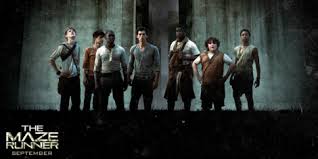The Maze Runner entertains

The joys of a freshman English class: awkward silences, lackluster lessons luring listeners to sleep and the kindling of friendships among 14-year-olds. From the joys of grammar lessons to the confusion of reading books like To Kill a Mockingbird, most lessons from this class often fades into darkness, never to be searched for or found in the future. One of these lectures likely explained the use and purpose of rhetorical questions.
But who cares about rhetorical questions? None other than the writers of “The Maze Runner”, another book adaptation of a book series that rivaled “The Hunger Games”series in popularity for years. Wes Bell directs the movie starring “Teen Wolf” star Dylan O’Brien as Thomas, an oblivious hunk who refuses to follow instructions given by any of the other characters. Thomas Brodie- Sangster plays Newt, the co-leader of the boys stuck in the Glade, surrounded by a concrete and metal maze.
The plot of “The Maze Runner” excites and scares viewers, combining dystopian themes with classic survivor ideals, such as a history of unrest and the formation of a tribal hierarchy. Viewers also can look forward to a sequel, as a thrilling twist leads to more questions than answers. With multiple crises, gory action and shocks sprinkled throughout, the action of the film succeeded in attracting fans to the bloody and adrenaline packed violence the movie entails.
But no creature is without sin. In “The Maze Runner”, the writers lived and breathed rhetorical questions when writing the screenplay. The constant firing of back-to-back questions, like a revolver operated by the best of cowboys, unnaturally haunts every conversation. The typical line “What am I doing here?” might have been said by the characters a dozen times. The character’s conversations are unnatural, full of awkward silences and predictable lines. Besides the few main characters, all of the boys in the Glade remain nameless, without any recognition. The few main characters only exist as static characters, with few traits.
In addition to weak character development, abundances of cliches, such as a chubby, goofy supporting character, dozens of dumb lines and the everpresent “ Oh, no, I’ve been shot and the main character cries over my dead body as he’s dragged away” situation. The movie also struggles in adding key details from the books, such as telecommunication between two characters, and insults that the Gladers use as a part of their developed speech.
*SPOILERS*The film presents intriguing situations that symbolize events that have happened in history. When Gally confronts the Thomas during the Glader’s escape attempt, he says that they belong to the Glade; they must stay there. This can be related to current situations where children form close ties to a home or place; if they are taken from the home or place, they will break down, as they leave the only place they have every known; the future, dark and unknown, is extremely terrifying for the child, like Gally was of the outside world.
Effects primarily centered around the complex Grievers, as their hydraulic limbs eerily snatched and grabbed some of the Gladers, during the final fight scene between the fleeing Gladers and the Grievers. Perhaps the most visually appealing scene occurred at the end of the film, as a helicopter panned over the Maze and the Glade. The Gladers, seeing the whole
“The Maze Runner” delivered an intriguing mix of drama and thriller in 113 minutes. Unfortunately, the action scenes must be buffered with lingering, robotic dialogue between undeveloped characters. But if thinking about which movie to see, “The Maze Runner” is worthy the $10 investment.

